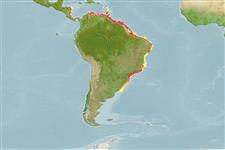Common names from other countries
>
Carangiformes (Jacks) >
Carangidae (Jacks and pompanos) > Scomberoidinae
Etymology: Oligoplites: Greek, oligos = small + Greek, hoplites = armed (Ref. 45335).
More on author: Bloch.
Environment: milieu / climate zone / depth range / distribution range
Écologie
marin; saumâtre benthopélagique; profondeur ? - 40 m (Ref. 9626). Tropical; 16°N - 35°S, 89°W - 34°W
Western Atlantic: Laguna de Caratasca, Honduras to Montevideo, Uruguay.
Taille / Poids / Âge
Maturity: Lm ? range ? - ? cm
Max length : 50.0 cm TL mâle / non sexé; (Ref. 5217); common length : 35.0 cm TL mâle / non sexé; (Ref. 5217); poids max. publié: 900.00 g (Ref. 3277)
Adults are found over soft bottoms of the continental shelf, often inshore and in estuaries. Also pelagic and encountered throughout the water column (Ref. 9626). May feed on plankton by ram-filtering. Juveniles feed mainly on planktonic crustaceans and chaetognaths, to a minor extent on benthic crustaceans and polychaetes, besides scales taken from larger fishes (Ref. 30206, 40402). Mature females generally spawn in summer. Eggs are pelagic (Ref. 35237). Marketed mostly fresh.
Life cycle and mating behavior
Maturities | Reproduction | Spawnings | Egg(s) | Fecundities | Larves
Cervigón, F., 1993. Los peces marinos de Venezuela. Volume 2. Fundación Científica Los Roques, Caracas,Venezuela. 497 p. (Ref. 9626)
Statut dans la liste rouge de l'IUCN (Ref. 130435)
CITES (Ref. 128078)
Not Evaluated
Menace pour l'homme
Harmless
Utilisations par l'homme
Pêcheries: intérêt commercial mineur; Aquarium: Commercial
Outils
Can't connect to MySQL database fbquizv2. Errorcode: Too many connections
